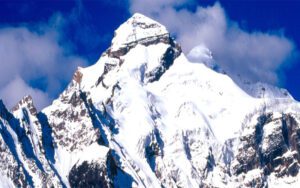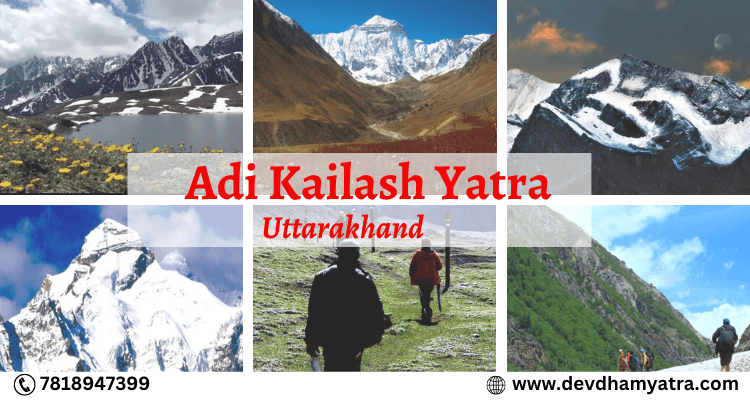The Adi Kailash Yatra, also known as the Chhota Kailash Yatra or Om Parvat Yatra, is a sacred pilgrimage in the Uttarakhand region of India. It is considered a significant spiritual journey for devotees, as it is believed to be an alternative to the Kailash Mansarovar Yatra in Tibet. Here’s some information about the Adi Kailash Yatra:
Location: Adi Kailash is located in the Dharchula district of Uttarakhand, near the border with Nepal. It is situated in the Kumaon Himalayas and is known for its stunning natural beauty and religious significance.
Importance: Adi Kailash is revered by Hindus as a sacred mountain associated with Lord Shiva. The mountain resembles the shape of the mythical Mount Kailash in Tibet and is considered its replica. The pilgrimage is undertaken by devotees seeking spiritual blessings and an opportunity to connect with Lord Shiva.


Route: The Adi Kailash Yatra typically starts from Dharchula, which is well connected by road from major cities in Uttarakhand. From Dharchula, the journey proceeds to Gunji/Nabi, and then pilgrims trek through the scenic trails of the Kumaon Himalayas. The trekking route passes through picturesque landscapes, dense forests, and small villages. The final destination is Adi Kailash, where devotees offer prayers and perform rituals.
Duration: The duration of the Adi Kailash Yatra can vary depending on the itinerary and individual preferences. It generally takes around 8-12 days to complete the entire pilgrimage, including the trekking portion.
Challenges: The Adi Kailash Yatra involves trekking at high altitudes and navigating through challenging terrains. The trek can be physically demanding, and acclimatization to the high altitude is essential. The weather conditions can be unpredictable, with cold temperatures and occasional rainfall. It is advisable to be well-prepared, physically fit, and have proper trekking gear for a safe and comfortable journey.
Permits and Permissions: Pilgrims undertaking the Adi Kailash Yatra require permits from the local authorities. It is advisable to obtain the necessary permits and permissions beforehand to ensure a smooth and hassle-free journey.
Accommodation: Accommodation options along the Adi Kailash Yatra route are limited due to the remote nature of the region. Basic guesthouses and camping facilities may be available at certain points during the trek. It is advisable to carry the necessary camping gear or make prior arrangements with tour operators.
The Adi Kailash Yatra offers a unique spiritual experience in the serene Himalayan landscapes. It is advisable to consult with experienced tour operators, follow safety guidelines, and plan the journey carefully to ensure a fulfilling and memorable pilgrimage.
Itinerary for Adi Kailash Yatra:
The itinerary for the Adi Kailash Yatra can vary based on individual preferences, available time, and logistical considerations. Here’s a sample itinerary to give you an idea of the typical schedule for the Adi Kailash Yatra from Uttarakhand:
Day 1: Delhi to Haldwani
Day 2: Haldwani to Pithoragarh
Day 3: Pithoragarh to Dharchula
Day 4: Dharchula – Tawaghat- Gunji/ Nabi
Day 5: Gunji/ Nabi- Kutti- Jollingkong-Parvati Tal- Mount Adi Kailash
Day 6: Jollingkong- Kutti- Nabi-Gunji- Kalapani-Om Parvat & return to Gunji
Day 7: Gunji – Tawaghat- Dharchula
Day 8: Dharchula to Almora
Day 9: Almora to Haldwani (Kathgodam) & return to Delhi
Please note that this itinerary is a general guideline and can be customized based on your preferences and available time. It is essential to consult with experienced tour operators or local guides for the most up-to-date information, route conditions, and necessary permits before.
Note: Yatris can travel to New Delhi by plane or train from any location. The route described above will be followed after reaching New Delhi.
Travel Tips:
- Physical Fitness: The Adi Kailash Yatra involves trekking at high altitudes and navigating through challenging terrains. It is advisable to engage in regular physical exercise and prepare yourself physically before undertaking the journey. Cardiovascular exercises, hiking, and trekking practice can help improve stamina and endurance.
- Acclimatization: Acclimatization to high altitude is crucial to avoid altitude sickness. Take a few days to acclimatize in Dharchula or nearby areas before starting the trek. Stay hydrated, avoid strenuous activities initially, and listen to your body. If you experience symptoms like dizziness, headache, nausea, or shortness of breath, descend to lower altitudes and seek medical assistance if necessary.
- Weather and Clothing: The weather in the Himalayas can be unpredictable, so pack accordingly. Layered clothing is recommended to adapt to temperature fluctuations. Carry warm clothing, rain gear, sturdy trekking shoes, and hats to protect against the sun. Pack a good-quality sleeping bag and a waterproof tent if you plan to camp.
- Trekking Gear: Ensure you have the essential trekking gear such as a backpack, trekking poles, headlamps, water bottle, sunglasses, sunscreen, and a first aid kit. Carry energy bars, snacks, and sufficient drinking water as there might not be easily accessible water sources along the trekking route.
- Permits and Permissions: Obtain the necessary permits and permissions from the local authorities before starting the Adi Kailash Yatra. Consult with tour operators or local guides who can assist you in obtaining the required documents.
- Guided Tour: Consider joining a guided tour or hiring a local guide who is familiar with the trekking route and local customs. They can provide valuable insights, ensure safety, and assist with navigation and communication in case of any emergencies.
- Pack Light: As you’ll be trekking, it is advisable to pack light. Carry only the essential items and avoid unnecessary weight. Keep your backpack organized for easy access to important items during the trek.
- Hygiene and Sanitation: Carry personal hygiene items such as wet wipes, hand sanitizers, and toilet paper. Maintain cleanliness and dispose of waste responsibly. Use eco-friendly products and respect the environment during your journey.
- Safety: Prioritize your safety throughout the journey. Stay hydrated, follow the instructions of your guide, and avoid taking unnecessary risks. In case of any emergency or health concerns, seek immediate medical assistance.
It is advisable to consult with experienced tour operators or local guides for the most up-to-date information and guidance specific to the Adi Kailash Yatra. They can provide personalized advice based on the current conditions and help ensure a safe and memorable pilgrimage experience.
FAQs:
Q1. Where is Adi Kailash located?
A. Adi Kailash is located in the Dharchula district of Uttarakhand, near the border with Nepal. It is situated in the Kumaon Himalayas and offers stunning views of the surrounding peaks and valleys.
Q2. How long does the Adi Kailash Yatra take?
A. The duration of the Adi Kailash Yatra can vary depending on the itinerary and individual preferences. Typically, it takes around 8-12 days to complete the entire pilgrimage, including the trekking portion.
Q3. What is the best time to undertake the Adi Kailash Yatra?
A. The best time to undertake the Adi Kailash Yatra is during the summer months of May to June and the post-monsoon months of September to October. During these periods, the weather is relatively stable, and the trekking routes are more accessible.
Q4. What are the accommodation options during the Adi Kailash Yatra?
A. Accommodation options along the Adi Kailash Yatra route are limited due to the remote nature of the region. Basic guesthouses and camping facilities may be available at certain points during the trek. It is advisable to carry the necessary camping gear or make prior arrangements with tour operators.
Q5. What should I pack for the Adi Kailash Yatra?
A. Some essential items to pack for the Adi Kailash Yatra include warm clothing, rain gear, sturdy trekking shoes, a sleeping bag, a backpack, trekking poles, a headlamp, a water bottle, sunglasses, sunscreen, a first aid kit, and personal hygiene items. It is advisable to pack light and carry only the necessary items for the trek.












 Shri Eklingji Temple in Udaipur, Rajasthan – A Sacred Marvel of Mewar
Shri Eklingji Temple in Udaipur, Rajasthan – A Sacred Marvel of Mewar 






